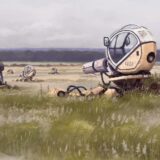I had the opportunity to hear Sam-Snoek Brown speak about his book Hagridden, a project sponsored partly by the Oregon Literary Fellowship this summer. Amazed at what he had to say, I bought the book, read it, and asked if I could interview Sam for Amazing Stories, because indeed, this is an amazing story.
REVIEW
Sam is articulate in his phrasing and expresses urgency in his writing. I smiled to myself at the style he uses i.e. no quotations, just a fluid continuation that makes sense as though grammatical rules are for the educated, not the simple folk who live in the marshes of the South, which is where the story takes place. Interesting enough, I had just finished another novel by an Irish author, pen name Flann Obrien and his At Swim-Two-Birds written in 1939 with the exact same style. Not sure if it was serendipity, but well worth noting.
Hagridden, “to afflict with worry, dread, need, or the like; torment.”
The tale takes place during the American Civil War, but not on any battle field most of us are familiar with. Two woman living alone are found in the marshes of the bayou doing what they can to survive. And it’s not pretty. But when you’re near starving, and there’s not a stranger nor barely a friend you can trust, its a wolf-eat-dog world and you either kill to survive, or die. The story moves along at a steady pace, replacing one thrilling moment with another. No frills, no apologies, Sam gives us an unromantic image of the south during the war with Cajun myths and legends an underlying theme.
INTERVIEW
1. You have quite a few credits listed in the back of your book. Tell me about the research you did for Hagridden.
I’ve always been a bit of a Civil War nerd, since I was about 10 or so. So I’ve been at the research behind this book for a long time. But Hagridden doesn’t bother with generals or battlefield tactics or politics—it’s about the people who avoided the war until they got swept up into it, about the poor folks trying to survive back home—so when I first had the idea for the specific story of Hagridden, I had to look in some less-common places for material. I read a lot of first-hand accounts, letters from soldiers and contemporary newspaper articles and diaries from women back on the homefront. And when I received an Oregon Literary Fellowship to develop and finish the novel, I traveled to the Louisiana bayou, where I not only hit the local libraries for their specialized collections but also spoke to the local people, visited living history museums, and just walked the bayou myself. (I frequently found myself in the middle of a desolate marsh with no company but alligators, which made my wife rather nervous but which was great for inhabiting the lives of my characters.)
2. What is the legend behind the rougarou and how was this legend used during the Civil War. Do you have some historical events that you refer to?
I don’t actually know how far back the legends about the rougarou go—it’s very much a living folk legend among certain Cajun families, and like most oral folk legends handed down parent to child at bedtime, it can be hard to trace back very far. I have friends who grew p hearing versions of the stories from their grandparents, who heard it from their grandparents . . . going back who knows how long. I don’t know of any specific references to the rougarou during the Civil War, but it almost certainly goes back at least that far, considering it developed partly from European French werewolf legends brought over in the French colonial period. Some folklorists also trace aspects of the rougarou legends to Native tales, so parts of the stories would have originated among the Native people who have always lived in the bayou.
But when I adapted the legends into the fearsome and mysterious (and very unsanctioned) “Rougarou Corps,” I definitely had in mind various historical precedents. I mostly took the rowdy and flamboyant Louisiana Tigers, added in elements of Western-theater guerilla fighters like Quantrill as well as some “secret-society” behavior, and exaggerated the unofficial “corps” into myth. The key, though, was that they were preying on the very real superstitions surrounding the existing rougarou legends, and while I grounded my story in reality, I hope there’s enough of an opening in there to allow that maybe—just maybe—some of those wild men were really something . . . unnatural.
I do love using the supernatural in realistic ways. In one of the novels I’m currently working on, about an outlaw paramilitary group operating in Texas during Reconstruction, I was playing with elements of demons and devils and trying to tie the gang of violent men in that book to a kind of vulture-worshipping cult. Eaters of death. Men who were too violent and too unruly for the “Texas Devils” of the Rangers but still fancied themselves lawmen, even if they abided by no laws but their own. But over the years, newer drafts of that book have become more grounded (pun intended), so I’m not sure how much of the devil or vulture aspects will be in the finished book.
3. Tell us how the rougarou is used in your book and where you got the idea from.
For me, the rougarou is a reference to the same thing the title is. I saw a reading and craft talk by Stephen Graham Jones several years ago, and this was after I’d published Hagridden but the way he spoke is the language I like best now. He said that he likes to use folklore and horror as literary shortcuts to character, so (in his example), if he wants to write about a violent, moody alcoholic, he could spend long chapters slogging through backstory and character development, or he could just make the character a werewolf and get the story going. The supernatural has always been a metaphor for the psychological, and in my case, I was thinking of the rougarou, both the cryptozoological figure and my fictional Rougarou Corps, as a comment on the horror that warfare visits on the human psyche. And it’s not just about a few individuals; it’s cultural, it’s societal, it’s systemic. The violence that we visit on others, we visit on ourselves—it comes back to haunt us—and that’s very much what the rougarou is about in my novel.
That’s what I had in mind when I titled the novel: “hagridden” was an early proto-psychological term for “night terrors” or “sleep paralysis,” the descriptions of which sounded a lot like an early attempt at describing PTSD. When I used the term as my title, I was thinking not only about the traumatized soldiers-turned-vicious killers in the rougarou corps or runaway Buford but also about the women in the book, who only engage in the desperate murders they do because they, too, have been traumatized by the war, not directly but just by proximity to it. And they’ve been traumatized by their lives, their harsh environment and the circumstances that a male-dominated culture left them in when the men all disappeared. I was even thinking about the townsfolk over in Leesburg, people living in relative comfort but still starved and battered by the economics of war, until even they begin to turn on each other.
To my mind, everyone in the book is “hagridden” by their circumstances. Everyone is haunted by a wildness that threatens to turn anyone into a rougarou-like monster, and—as in the werewolf legend—no one dares to talk about it aloud lest they acknowledge it and make their own inner horrors come true.
Samuel Snoek-Brown has a doctorate in creative writing from the University of North Texas and his work has appeared in dozens of print and online literary magazines. When he’s not teaching college or writing fiction, he works for Jersey Devil Press. Occasionally he’ll even show up online at snoekbrown.com. He lives with his librarian wife and their two cats in the Pacific Northwest. He is the author of the fiction chapbooks Where There Is Ruin (Red Bird Chapbooks 2016) and Box Cutters (sunnyoutside press, 2013), and he received a 2013 Oregon Literary Fellowship for his novel Hagridden (Columbus Press, 2014).










